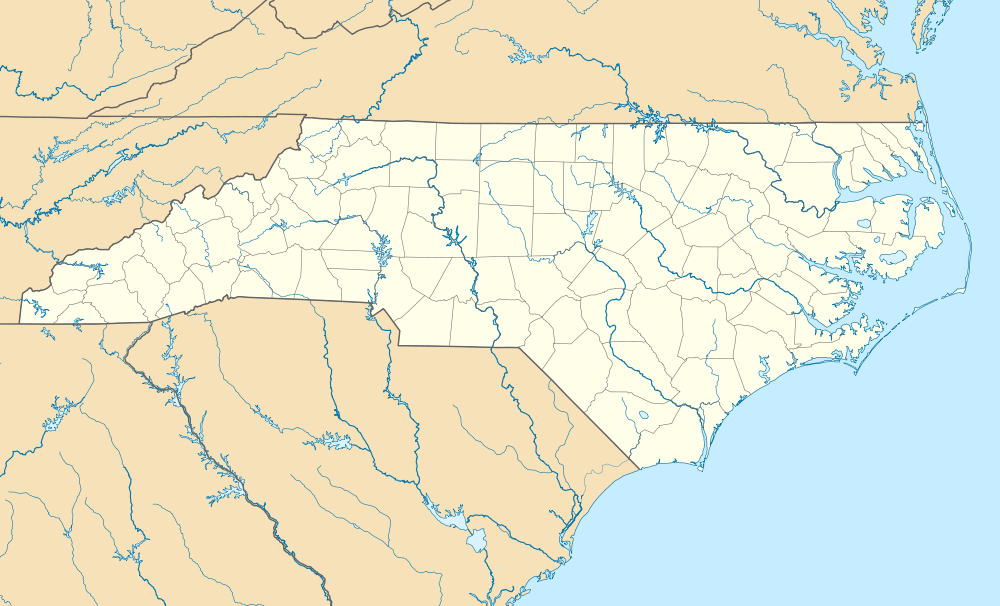Selma Union Depot
Selma Union Depot, also known as Selma Union Station, is a train station and museum in Selma, North Carolina. Built in 1924, it is currently served by two Amtrak passenger trains, the Palmetto and the Carolinian. It is located at 500 East Railroad Street in the heart of downtown Selma. The Silver Meteor and the Silver Star have their northern split here, but do not stop in Selma.
Selma, NC | |||||||||||||||
|---|---|---|---|---|---|---|---|---|---|---|---|---|---|---|---|
| Amtrak inter-city rail station | |||||||||||||||
| Location | 500 East Railroad Street Selma, North Carolina United States | ||||||||||||||
| Coordinates | 35°31′58″N 78°16′48″W | ||||||||||||||
| Owned by | Town of Selma | ||||||||||||||
| Line(s) |
| ||||||||||||||
| Platforms | 3 side platforms (2 used) | ||||||||||||||
| Tracks | 4 | ||||||||||||||
| Construction | |||||||||||||||
| Structure type | One story, gable roofed, brick building[1] | ||||||||||||||
| Parking | 20 spaces; free | ||||||||||||||
| Disabled access | Yes | ||||||||||||||
| Architect | A.M. Griffin (1924) Barry Rakes (2002) | ||||||||||||||
| Other information | |||||||||||||||
| Status | Unstaffed; attendant available | ||||||||||||||
| Station code | SSM (Amtrak) | ||||||||||||||
| History | |||||||||||||||
| Opened | 1867[1] | ||||||||||||||
| Rebuilt | 1924, 2002 | ||||||||||||||
| Traffic | |||||||||||||||
| Passengers (FY2018) | 12,930[2][3] | ||||||||||||||
| Services | |||||||||||||||
| |||||||||||||||
| |||||||||||||||
Selma Union Station | |||||||||||||||
Plaques for the depot's NRHP status and 2002 restoration. | |||||||||||||||
| Location | E. Railroad St., Selma, North Carolina | ||||||||||||||
| Built | 19 July 1924 | ||||||||||||||
| Architect | Griffin, A.M. | ||||||||||||||
| MPS | Selma, North Carolina MRA | ||||||||||||||
| NRHP reference No. | 82003482[4] | ||||||||||||||
| Added to NRHP | June 24, 1982 | ||||||||||||||
| Location | |||||||||||||||
 Selma, NC Location within North Carolina | |||||||||||||||
The station appears in Amtrak timetables as Selma-Smithfield.
History
The current station was built as a replacement for the original 1897 wood frame structure in 1924 by architect A.M. Griffin,[1] for the Atlantic Coast Line and Southern Railroads, and closed in 1971, when Amtrak took over passenger service throughout much of the country. In 1975, the people of the city thwarted the station's demolition, and beginning the year after this reopened the station as a museum devoted to the city's railroad heritage. It was added to the National Register of Historic Places on June 24, 1982.[1] Amtrak service to Selma began on October 31, 1982, when the Palmetto began stopping there.[5]
Layout
The old freight house is located to the west of the station on Railroad Street and South Webb Avenue. A maintenance shed is located to the north. Two tracks exist along the east side of the station, another one exists along the south side, and the fourth is a section of curved track behind the station that connects two of the tracks. Three platforms exist at the station, one of which is along the curved track. A parking space exclusively for the handicapped can be found between the curve and the station house.
Routes
References
- Thomas A. Greco (August 1980). "Union Station" (pdf). National Register of Historic Places - Nomination and Inventory. North Carolina State Historic Preservation Office. Retrieved 2015-01-01.
- "Selma, NC (SSM) - Great American Stations". Amtrak's Great American Stations. Retrieved July 17, 2019.
- "Amtrak Fact Sheet, FY2017, State of North Carolina" (PDF). Amtrak. November 2017. Retrieved February 3, 2019.
- "National Register Information System". National Register of Historic Places. National Park Service. July 9, 2010.
- Norton, Debbie (November 11, 1982). "Businessbeat". Star-News. Retrieved 2011-07-04.

